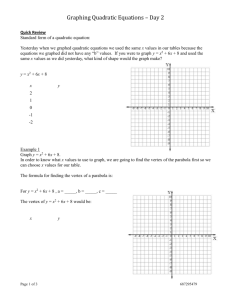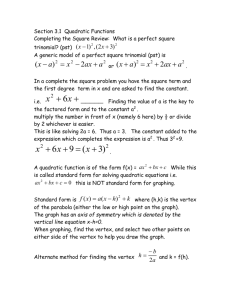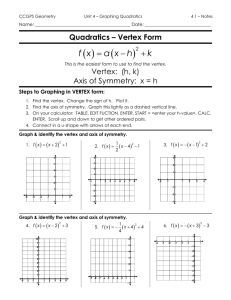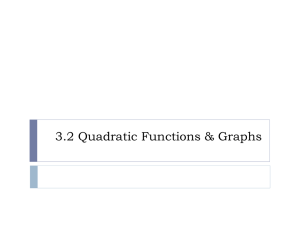Notes Solving Quadratics By Factoring
advertisement
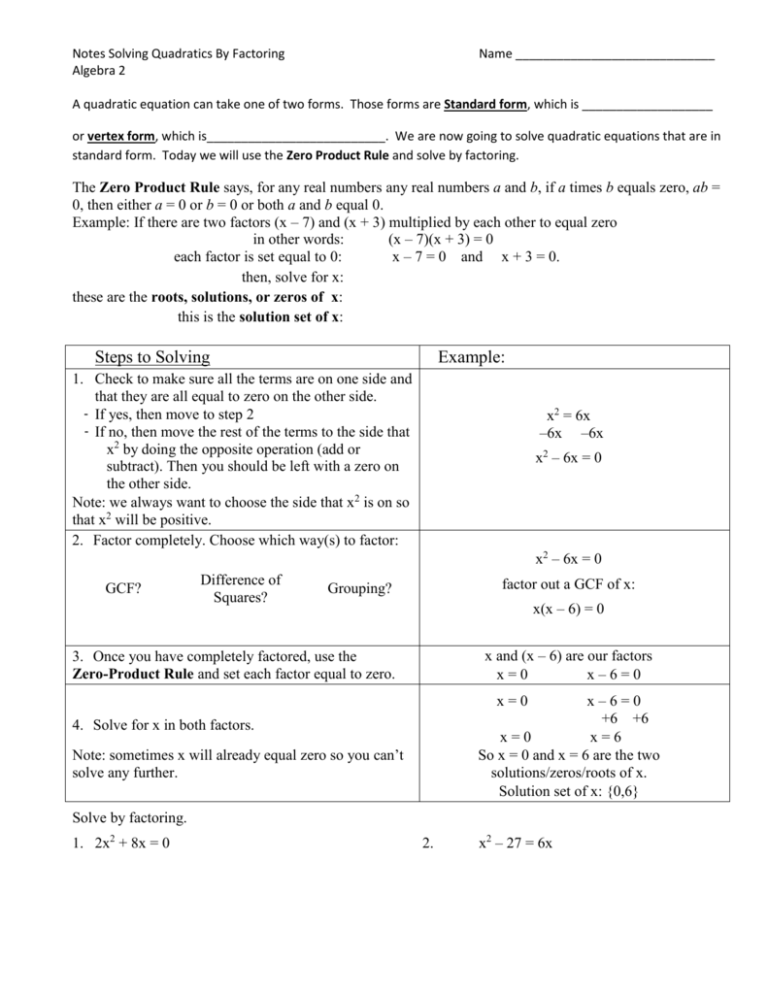
Notes Solving Quadratics By Factoring
Algebra 2
Name _____________________________
A quadratic equation can take one of two forms. Those forms are Standard form, which is ___________________
or vertex form, which is__________________________. We are now going to solve quadratic equations that are in
standard form. Today we will use the Zero Product Rule and solve by factoring.
The Zero Product Rule says, for any real numbers any real numbers a and b, if a times b equals zero, ab =
0, then either a = 0 or b = 0 or both a and b equal 0.
Example: If there are two factors (x – 7) and (x + 3) multiplied by each other to equal zero
in other words:
(x – 7)(x + 3) = 0
each factor is set equal to 0:
x – 7 = 0 and x + 3 = 0.
then, solve for x:
these are the roots, solutions, or zeros of x:
this is the solution set of x:
Steps to Solving
Example:
1. Check to make sure all the terms are on one side and
that they are all equal to zero on the other side.
- If yes, then move to step 2
- If no, then move the rest of the terms to the side that
x2 by doing the opposite operation (add or
subtract). Then you should be left with a zero on
the other side.
Note: we always want to choose the side that x2 is on so
that x2 will be positive.
2. Factor completely. Choose which way(s) to factor:
x2 = 6x
–6x –6x
x2 – 6x = 0
x2 – 6x = 0
GCF?
Difference of
Squares?
factor out a GCF of x:
Grouping?
x(x – 6) = 0
x and (x – 6) are our factors
x=0
x–6=0
3. Once you have completely factored, use the
Zero-Product Rule and set each factor equal to zero.
x–6=0
+6 +6
x=0
x=6
So x = 0 and x = 6 are the two
solutions/zeros/roots of x.
Solution set of x: {0,6}
x=0
4. Solve for x in both factors.
Note: sometimes x will already equal zero so you can’t
solve any further.
Solve by factoring.
1. 2x2 + 8x = 0
2.
x2 – 27 = 6x
3. 2x2 + 5x = –3
4.
3x2 + 21x = 24
Write a quadratic equation with the given roots. Use the form ax2 + bx + c = 0, where a, b and c are
integers.
5.
7, -3
6.
-6, 4
7.
1
,5
2
8.
1
,4
3
9. 6 x x 2 5
10.
9x2 – 100 = 0
11. 6x2 – 20x + 14 = 0
12.
16 – 6x2 = 19x + 8 – 12x2
Solve by factoring
Use the Quadratic Formula and the Discriminant
A. Review of Simplifying Radicals and Fractions
Simplify expression under the radical sign ( 1 i ); reduce
Reduce only from ALL terms of the fraction.
(You can’t reduce a number outside of a radical with a number inside of a radical)
Make sure that you have TWO answers
Simplify:
6 18
2
1.)
5 20
2
2.)
4 20
4
3.)
8 27
2
4.)
9 (5)2 (5)(2)(3)
4
5.)
9 (6)2 4(3)(3)
4
6.)
B. Solving Quadratics using the Quadratic Formula
So far, we have solved quadratics by: (1) _______________, (2) ______________, and
(3) ___________________.
The final method for solving quadratics is to use the quadratic formula.
Solving using the quadratic formula:
Put into standard form (ax2 + bx + c = 0)
List a = , b = , c =
b b2 4ac
x
2a
Plug a, b, and c into
Simplify all roots (look for
1 i ); reduce
Solve by using the quadratic formula:
2
1.)
x + x = 12
x
b b2 4ac
2a
(std. form):
a = _____
b = _____
c = _____
2
2.) 5x – 8x = -3
b b2 4ac
x
2a
(std. form):
a = _____
b = _____
c = _____
3.) -x2 + x = -1
4.) 3x2 = 7 – 2x
5.) -x2 + 4x = 5
6.) 4( x 1)2 6 x 2
C. Using the Discriminant
Quadratic equations can have two, one, or no solutions (x-intercepts). You can determine how many solutions a
quadratic equation has before you solve it by using the ________________.
The discriminant is the expression under the radical in the quadratic formula: x
b b2 4ac
2a
Discriminant = b2 – 4ac
If b2 – 4ac < 0, then the equation has 2 imaginary solutions
If b2 – 4ac = 0, then the equation has 1 real solution
If b2 – 4ac > 0, then the equation has 2 real solutions
A. Finding the number of x-intercepts
Determine whether the graphs intersect the x-axis in zero, one, or two points.
1.) y 4 x 2 12 x 9
2.) y 3x 2 13x 10
B. Finding the number and type of solutions
Find the discriminant of the quadratic equation and give the number and type of solutions of the equation.
3.) 3 x 2 5 x 1
5.) 9x2 – 6x = 1
4.) x 2 3 x 7
6.) 4x2 = 5x + 3
Notes Graphing Quadratic Functions
Standard form of a quadratic equation:
Name_______________________
f ( x) ax 2 bx c
A ____________________ is a function that can be written in the form y ax 2 bx c where a, b, and c are real
numbers and a 0. Ex: y 5 x 2
y 2 x 2 7
y x2 x 3
The graph of a quadratic function is a U-shaped curve called a ________________. The maximum or minimum
point is called the _____________
Identify the vertex of each graph; identify whether it is a minimum or a maximum.
1.)
2.)
Vertex: (
3.)
,
) _________
Vertex: (
4.)
,
) _________
Vertex: (
,
) _________
Key Features of a Parabola:
Vertex: (
,
) _________
y ax 2 bx c
Direction of Opening: When a 0 , the parabola opens ________:
When a 0 , the parabola opens ________:
Width: When a 1 , the parabola is _______________ than y x 2
When a 1 , the parabola is ________ than y x 2
Vertex: The highest or lowest point of the parabola is called the vertex, which is on the axis of
symmetry. To find the vertex, plug in x
b
and solve for y. This yields a point
2a
b
2a
Axis of symmetry: This is a vertical line passing through the vertex. Its equation is: x
x-intercepts: are the points where the parabola crosses the x-axis. Plug in y = 0 and solve for x.
y-intercept: is the point where the parabola crosses the y-axis. Plug in x = 0 and solve for y.
Graphing in STANDARD FORM ( y ax 2 bx c ): we need to find the vertex first.
Vertex
Example.
f ( x) x 2 2 x 3
- list a = ____, b = ____, c = ____
- find x =
b
2a
- plug this x-value into the function to find the ycoordinate
- this point (x, y) is the vertex of the parabola
Graph the following. Then determine the vertex and the equation for the axis of symmetry.
5.
f ( x) x 2 2 x 1
6.
y x 2 2x
7.
y x 2 4x 4
Vertex:__________
Vertex:__________
Vertex:__________
Axis of Symmetry: ________
Axis of Symmetry: ________
Axis of Symmetry: ________
Max or min? _______
Max or min? _______
Max or min? _______
Direction of Opening________
Direction of Opening________
Direction of Opening________
Without graphing the quadratic functions, complete the requested information:
8.) f ( x) 3x 2 7 x 1
9.) g ( x)
5 2
x x3
4
What is the direction of opening? _______
What is the direction of opening? _______
Is the vertex a max or min? _______
Is the vertex a max or min? _______
Wider or narrower than y = x2 ? ___________
2
Wider or narrower than y = x ? __________
10.)
y
2 2
x 11
3
11.) y 0.6 x 2 4.3x 9.1
What is the direction of opening? _______
Is the vertex a max or min? _______
What is the direction of opening? _______
Wider or narrower than y = x2 ? __________
Is the vertex a max or min? _______
Wider or narrower than y = x2 ? ___________
Vertex form of a quadratic function: f(x) = a(x – h)2 + k
The parent function y = x2 is graphed to the right.
Note its vertex (___, ___) and its width.
When given an equation in vertex form here’s how
you find:
The vertex is (___, ___).
The axis of symmetry is x = ___.
The graph opens up if a ____ 0 and
down if a ____ 0.
Graph the following. Then determine the vertex and the equation for the axis of symmetry.
12. y x 1 2
2
13. y x 2 4
2
14. y x 3 2
2
16.
y ( x 2) 2
15. y x 2 4
2
17. y x 1
HW Graphing Quadratics
Name ________________________________
Algebra 2
Date ______________________ Pd_________
Determine whether each equation is a linear or quadratic.
1.
y x4
2.
y 2 x 2 3x 5
3.
y 3x x 2
Without graphing the function identify the vertex and the axis of symmetry of each parabola.
4.
y x2 4x 7
5.
y 2x2 2x 1
6.
y 4 x 2 12 x
Vertex:__________
Vertex:__________
Vertex:__________
Axis of Symmetry: ________
Axis of Symmetry: ________
Axis of Symmetry: ________
Max or min? _______
Max or min? _______
Max or min? _______
Direction of Opening________
Direction of Opening________
7.
y x2 7 x 6
8.
y x2
Direction of Opening________
9.
y x2 5
Vertex:__________
Vertex:__________
Vertex:__________
Axis of Symmetry: ________
Axis of Symmetry: ________
Axis of Symmetry: ________
Max or min? _______
Max or min? _______
Max or min? _______
Direction of Opening________
Direction of Opening________
Direction of Opening________
The following functions are in vertex form. Graph the function.
10.
y x2
11.
y
y x2 3
12.
y
y
x
13.
y x 1 2
2
x
14.
y
y x 3 2
2
x
15.
y
x
y x2 4
y x 2 4
2
y
x
x




